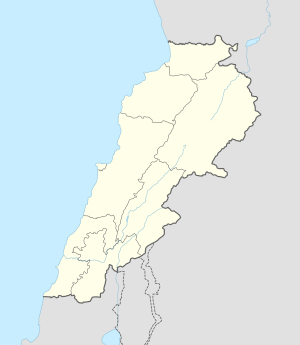Bdadoun
|
Bdadoun بدادون |
|
|---|---|
| Location in Lebanon | |
| Coordinates: 33°48′36″N 35°33′40″E / 33.81000°N 35.56111°ECoordinates: 33°48′36″N 35°33′40″E / 33.81000°N 35.56111°E | |
| Country |
|
| Governorate | Mount Lebanon Governorate |
| District | Aley District |
| Elevation | 1,610 ft (490 m) |
| Time zone | EET (UTC+2) |
| • Summer (DST) | +3 (UTC) |
Bdadoun (Arabic: بدادون) (also Bdadun, Bde‘doun, Bdādūn), is a town in Mount Lebanon which makes up one of the 70 towns and villages in the Lebanese district of Aley. It has an estimated population of 3,000. It is 490 meters above sea level and 15 kilometres from the capital Beirut. It is known as a summer holiday location.
The name Bdadoun derives from the Phoenician noun Bd-Adoun (بِد-اَدون ) or "House of Adoun", the Canaanite god of the sun Adoun or Adonis, also known as Tammuz.
In the year 1144, fighting erupted between the Christians in the North Lebanon regions of Jbeil and Keserwan districts. The king Barquq (الملك الظاهر برقوق) took the opportunity and ordered an invasion of that Christian dominated area. The result was an outflow of people that settled in the Chouf District. This region (especially the areas surrounding Beirut) was ruled by the Tanukhids (التنوخيّون). The Tanukhs (also called Buhturs) where the Druze hereditary lords of the Gharb (area surrounding Beirut). The Buhturs were replaced by the Ma'ans when the Ottomans conquered in the early 16th century. The area surrounding Bdadoun remained under autonomous Ottoman rule until the end of World War I.
The first settlers of Bdadoun came from the North Lebanon Maronite families as peasants. They found an uninviting land made of mostly rocky landscape strewn with oaks, wild figs, vines and some olive trees. Local dwellers built stone terraces planted fruit trees such as apricot, almonds, pear, apple, pomegranates, and plum trees. It is the latter, that Bdadoun is mostly known for plums (Turkish: Erik, or Can Erik. Arabic: al-barqūq, البَرقوق ) and holds an annual harvest festival in May. This plum is believed to be a close relative of the Greengage.
This is not to be mistaken with the Chinese Plum or Loquat which is also grown in Bdadoun and called Akkidinya or Akkadeneh. (Arabic: اككي دني. Turkish: yeni dunya, yedi dunya)
...
Wikipedia

